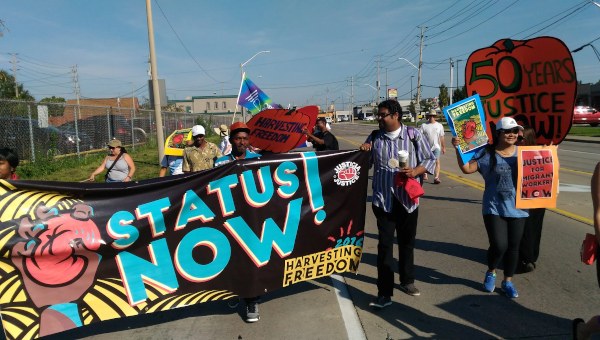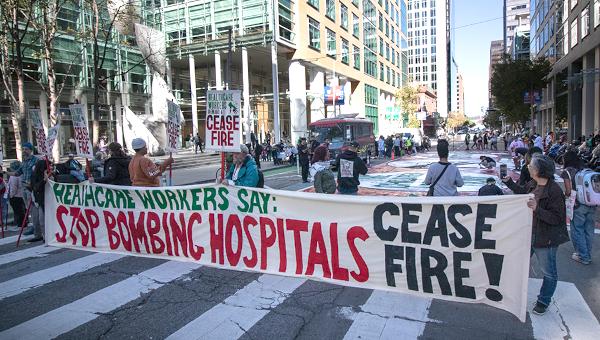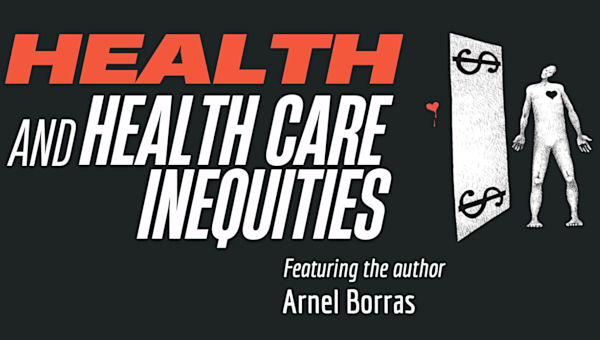Striking Down Farm Workers – It Is the Law’s Way
These days we hear and read a lot about essential workers. It is not always clear whether workers ought to be characterized as essential ones, but there can be little doubt that the people who work on farms are essential workers. They put food on our tables.
Policy-makers are conscious of the importance of agricultural workers and they ensure a plentiful supply of farm labour. Canada imports 50,000 farm workers every year, giving them special visas to enter and work in Canada. And it treats these migrant workers abysmally. The pandemic threw a sharp light on the appalling housing conditions, the severe constraints on access to Canadian benefit programmes, and the fear of deportation these essential workers have to deal with every day. It turns out that this oppression of migrant agricultural workers is the low point of the normalized degradation of agricultural workers in general. Agricultural workers are treated like dirt by our laws, by our governments, and, of course, by their employers. A recent decision by the Ontario Supreme Court of Justice, Divisional Court, has rammed home this point.
The case is called United Food and Commercial Workers International Union (UFCW) v. Aurora Cannabis Enterprises Inc. Agricultural workers had lodged their umpteenth attempt to get a court to acknowledge that they, like other workers in Canada, should have a right to strike. Once again, they failed. These essential workers are not legally entitled to use the only realistic weapon that might enable them to attain terms and conditions of work to help them live somewhat securely and work in dignity. Security and dignity are not for them.

A Special Kind of Inferior Workers
Agricultural workers have never concluded a legally enforceable collective agreement. Inevitably, their conditions and terms of work are poor, and their health and safety severely compromised.
In Ontario, agricultural workers have been treated as belonging to a special category of workers, as inferior workers. To put it baldly, workers who unquestionably are essential to our society’s well-being are treated, deliberately and intentionally, very poorly by that society, by us.
Before 1994, these workers were excluded from the system of capital-labour regulation created by the Ontario Labour Relations Act. That statute establishes Ontario’s version of the US’s Wagner Act, which legitimates the operations of unions in the private sectors, and most importantly, giving them the right to strike in certain circumstances. However, agricultural workers were consciously excluded. The discrimination became politically embarrassing, and by 1994, it had become clear that some scheme to allow agricultural workers to protect themselves had to be fashioned. This led to the enactment of the Agricultural Labour Relations Act. But the embarrassment was not pressing enough to treat agricultural workers as if they were run-of-the-mill workers. While they were to be permitted to form collectives, they were not to be given the right to strike because any collectivized withdrawal of their services might lead to catastrophic results for the public and, even more importantly, their employers. The logic is brutal.
The production of food is essential. This makes the work done by farm workers essential. Instead of according them the respect this warrants, instead of allowing them to get the kind of return that their essential services should allow them to claim, they are forbidden from using their economic power. Yet the owners of the means of production continuously use their economic power to subjugate both the working class and governments. They are allowed to threaten to withhold their service – the investment of capital – in order to squeeze out as much profit for themselves as possible. What is good enough for the fat geese is too good for the lean ganders. But not always. For example, the police, are treated as essential workers who may not strike but must be given very good conditions and terms. But then they serve the interests of the ruling class more directly.
Agricultural workers felt singled out: they had potential bargaining power, and yet, were not allowed to use it effectively. By now, the Charter of Rights and Freedoms had become part of the constitutional structure of the country and, as it guaranteed the freedom to associate and forbade government from interfering with that cherished right, farm workers went to court and argued that the government was indefensibly denying them a freedom guaranteed by the Charter. In 2001, the Supreme Court of Canada, in the case Dunmore v. Ontario (Attorney-General), agreed that their right to bargain collectively had been wrongly denied by Ontario but also noted that the right to bargain collectively did not mean they had the same right to bargain as had been won by workers in other sectors, namely, bargaining rights that included a form of the right to strike. It would be good enough if agricultural workers were given some (unspecified) means of bargaining collectively. The trickery of judicial methodology triumphed. The workers won but did not get the one thing they wanted. The Supreme Court flatly rejected the notion that farm workers should be treated as if they were just like workers in other private sectors entitled to pursue their interests with the help of legitimated strike action.
The modus operandi of lawyers and the judiciary is to finesse issues. Final, irrevocable victories are rarely the outcome. There is always room left to manipulate that outcome. This should be borne in mind by workers and their allies when their legal teams advise them to seek legal remedies.
To return: the decision in Dunmore forced the government to repair its now unconstitutional agricultural workers’ bargaining system. Taking its cue from the Supreme Court of Canada, it came up with a scheme giving agricultural workers the right to make demands by means of an association (note, not necessarily a union!) representing them but one not allowed to call a strike. Ontario’s agricultural workers now had collective bargaining rights that were to remain largely toothless. Agricultural workers had won a decision, sort of, but made no gains. No associations were formed; no collective agreements were reached.
Desperately, farm workers fought on. Strangely, given the Dunmore debacle, they went back to court. Perhaps this says something about the employing class’s intransigence and the workers’ lack of political clout. In any event, to court they went.
In a case called Fraser v. Ontario (Attorney-General) in 2011 (ten years had passed since the last judicial effort – the law moves glacially) the Supreme Court of Canada held that the Ontario scheme, because it permitted the workers to be represented by an association that turned any demands they made into some kind of collective demands, satisfied the requirements of the Charter of Rights and Freedoms. These workers were not, said the Supreme Court of Canada once again, entitled to a right to strike if a provincial government saw fit to deny it. Their Charter-guaranteed freedom to associate was adequately satisfied by a modicum of collective representation.
This reflects a view of freedom to associate as being hardly a freedom worthy of the name. A collective demand if not enforceable by the use of collectivized economic force is more like begging than bargaining. So, agricultural workers keep trying to get what a mature capitalist society promises all workers, a right to form unions with the right to strike to off-set the economic heft of the employing class. They feel not only the need to do so but also righteous in doing so because, for many of them, their workplaces look much more like industrial factories than the romantic family farm law-makers use as their model when they justify their policy of denying farm workers the rights factory and service sector workers have been granted.
Agricultural Workers and Unions
This has brought us to the 2021 Aurora case. The UFCW claimed that it had won the support of the majority of workers at a cannabis farm and asked the Ontario Labour Relations Board1 to give the union the full spectrum of bargaining rights it would get if the applicable scheme was the Ontario Labour Relations Act. That statute, of course, gives certified unions the right to conduct strikes in certain specified circumstances. To support that claim, the union first had to argue that Aurora’s employees were just like any other industrial-type workers, that is, not agricultural workers. They lost this argument. It was decided the production of a leaf crop like cannabis was much like the production of that other leaf crop, tobacco, already considered to be an agricultural undertaking and subject to the special agricultural laws.
The malleability of legal thinking comes into view. Producing tobacco, and now cannabis, is treated by law as the kind of productive activity which should not be interrupted. The law’s willing (but not legally necessitated) acceptance of the investors’ characterization of the nature of these kinds of investment as agricultural (even though contested by the workers who sense their conditions are much like those who work in factories) allows it to give those investors a hand-out by lowering their labour costs. Once they are classified as agricultural workers, the workers become more easily exploitable, even though the justification for this – that no worker must be in a position to interfere with the production of sorely needed food stuffs, such as wheat, potatoes, meat or fruit – does not exist. Capitalist law serves capitalism even when its own rule-making laws could allow it to serve the working class.
Unable to bring its case under the standard law regulating capital-labour bargaining in Ontario, the UFCW was forced into the maws of the Tribunal overseeing the unique 2002 agricultural bargaining law that had been the government’s response to the Dunmore decision. It is entitled the Agricultural Employees Protection Act 2002, (AEPA). The Tribunal administering its operations is known by its acronym, AFRAAT.
One of the UFCW’s main arguments was that, since the 2011 Fraser decision had upheld the constitutionality of the AEPA’s non-granting of the right to strike, there had been several other judicial holdings that appeared to take a more union-favouring view. In particular, in 2015, the Supreme Court of Canada, in a case called Saskatchewan Federation of Labour v. Saskatchewan, had said that a government’s explicit denial of a right to strike violated section 2(d) of the Charter of Rights and Freedoms, which guaranteed the freedom to associate. So, the UFCW argued, was it not plain that the AEPA, which did not bestow a right to strike on agricultural workers, was in breach of the Charter? Not plain enough, was the legal answer in the Aurora decision.
In Aurora, Ontario’s Divisional Court wrote that the Supreme Court of Canada’s emphatic pronouncement in the Saskatchewan case that the explicit denial of a right to strike was a violation of the Charter did not mean that section 2(d) of the Charter required governments to provide workers with a right to strike. The Ontario court said that what it actually meant was that it would be fine not to give a right to strike as long as the government left workers with a realistic chance to make their claims in respect of conditions and terms of work on a collective basis. In the Saskatchewan case, no such opportunity had been afforded workers, and the explicit denial of a right to strike became a fatal blow to the validity of the legislation. But this was not so in the Ontario case before it. The AEPA – as its administering Tribunal had found – did give the agricultural workers covered by the legislationenough room to bargain collectively. They could use representative associations to make demands on their behalf, and employers had to listen. Plenty of freedom here.
There is that legal finesse again! Here is that kind of subtle reasoning that fills lawyers and judges with pride and persuades the rest of the public that the legal profession is one where 95 per cent of its members give the other 5 per cent a bad name.
How much does the Agricultural Employees Protection Act 2002, in fact, do to allow both the Tribunal (the AFRAAT) and the Divisional Court to hold that its alternative to the right to strike satisfied the Ontario’s government to safeguard the freedom of association guaranteed by the Charter? Scandalously little. The AEPA provides that any representative freely chosen by some workers may make demands on an employer, who must acknowledge receipt and consider and discuss the demands in good faith. That is it! To be sure, it is true, in informal terms, that workers are permitted to make a collective demand but it is equally true that there is no permission to do anything but make a demand.
It is curling season. Imagine how one-sided the game would be if one team was given the right to play the last shot in every end, that is, if only one team had the “hammer” available to it. In curling, having the hammer is deemed to be the mightiest weapon a team can have and, to make the game fair, the teams are given equal opportunities to use it. If only one team had the hammer, the game would not be worth playing. It would be a rigged game.
Of course, the UFCW made this point. It argued that the AEPA scheme only amounted to a pretence by the Ontario government that it was satisfying the Supreme Court of Canada’s rulings in both Fraser and Saskatchewan Federation Labour. The UFCW pointed out that when the Supreme Court wrote of the need to have an alternative giving workers an opportunity to exercise collective action, it had clearly meant that to be a substantive opportunity. Here, the UFCW rightly contended, there was no substantial right to turn the alternative to a strike into effective collective action; the AEPA had merely given the workers some process rights, not substantial economic rights.
The Tribunal and the Divisional Court rejected this argument. Its logic, or rather its lack of logic, was astonishing. It held that (a), some collective action could be taken and (b), it did not have to be that much because it was still possible that agricultural workers could exercise an ages’ old right to strike which they possessed.
On its face, the argument made no sense. If there always had been a right to strike hidden in plain view, why had it been necessary at all for the Ontario government to provide any semblance of an ‘alternative collective dispute settlement scheme’? Why had it been necessary for agricultural workers to bring action after action trying to use the Charter’s freedom of association to give them a right to strike? Why was it that the Supreme Court of Canada had determined that the AEPA was constitutionally valid even though it did not provide for a right to strike because it had provided for “a process of engagement that permits employee associations to make representations to employers, which employers must consider and discuss in good faith”? Surely if there had always been a right to strike, there was no need for an alternative of any kind? What was this right to strike that, in the Aurora decisions, was said to exist and about which the union appeared to have no knowledge?

The answer was that the right to strike existed, as it had always existed, under common law. It existed, therefore, long before the enactment of the Wagner Act and its Canadian adaptations, even though those statutory regimes were hailed as victories for workers because they allowed the formation of unions that could call legally regulated strikes. The question poses itself: why had this common law right not sufficed? It is, of course, true that the common law does not prohibit strikes. But that truth hides a reality. It has long been agreed by labour lawyers and historians alike that the common law stood in the way of the actual exercise of the right to strike, even as it does not make the strike, as such, unlawful. When, in Aurora, the Tribunal and the Divisional Court observed that the UFCW was free to strike; they were being too cute for words. They had their forked legal tongues in both their cheeks.
The history of labour law is the history of the iron fist of the judiciary repressing workers who wanted to combine to win decent working conditions. As workers tried to defend themselves against capitalist exploitation by withholding their labour power in concert, common law was used to repress them, to have them jailed, deported, fined, and shamed. Workers have always had to go to legislatures to win reprieves from judicially supported oppressions. The history books, which should have been well-known to all the lawyers who participated in the Aurora decisions, are replete with examples of how the courts dealt with workers before they managed to win the rather skeletal legal protections they enjoy today.
Common Law and History
From the early 19th century on, as workers formed unions to defend themselves, courts would hold that they were combining to achieve unlawful ends, namely to make gains at the expense of employers while acting in restraint of trade. They could be punished as criminals. When legislatures agreed that such combinations (called conspiracies by the courts) should not be characterized as crimes, the courts held that they still amounted to civil wrongs, allowing judges to issue injunctions, that is, enforceable orders, suspending the combinations’ (that is, the conspiracies’) actions under pain of punishment. The common law did not forbid strikes but forbade the natural conduct which amounted to strikes. This was so damaging that, when the Wagner Act scheme was adapted in Ontario, a companion piece of legislation, the Rights of Labour Act, was enacted. It is still on our books today. It provides that, during a trade dispute, “any action done by two or more members of a trade union… is not actionable unless the act would be actionable if done without any agreement or combination.” It was assumed by the legislators (but not by the Tribunal and the Divisional Court in the Aurora case) that the common law, as it stood, did not allow any trade union to strike even as it did not outlaw the strike as such. Significantly, this protection against the courts’ inherent antipathy to the rights of workers has proven far from fool-proof. Courts can still act on their anti-working-class instincts.
Note that the Rights of Labour Act only gives protection when the action of a union would be a wrong if committed by an individual. How often will this happen? All the time. It is the norm for individuals engaged in a trade dispute to be in breach of some legal rule or another. It cannot be helped. For instance, if speech lambasts not just the unfairness of the employer but also exposes the employer’s heedlessness in the production of its goods or services, it may well be seen as a breach of an individual’s contract of employment. It is easily characterized as a lack of those vociferous workers’ loyalty, a breach of an implied duty owed by them as individuals to employers. The combined action in which such disloyal employees are involved is, then, no longer protected. Or, of course, the very act of withdrawing labour by a number of disappointed individuals may well lead to breaches of contracts between the target employer and other employees (all the more likely under the AEPA, as a union might represent only a fraction of the workers at a particular employer’s place of business) or suppliers or purchasers. Or, putting pressure on consumers or suppliers of the target employer, by individuals engaging in secondary boycotts – by picketing or pamphleteering or other lawful means – may be seen as inducing breaches of contracts or interferences with commercial relations. Or, threats by individuals to withhold their labour unless the target employer rids itself of non-union workers may be considered by the courts to constitute the civil tort of intimidation. All these actions during a trade dispute might make individuals liable for infractions of personal duties. The collectivized action will no longer be protected by the Rights of Labour Act. All these almost inevitable bits of wrongdoing by individuals during a capital-labour dispute become potential tools weaponizing courts asked to wreck protections given to workers. To save such worker-protection schemes, the English Parliament has felt itself compelled to provide specific remedies, over and above its equivalent of the Rights of Labour Act. We have not done so.
In this context, for the Tribunal and the Divisional Court to hold that, as the AEPA did not prohibit strikes, it was still open for workers to withdraw their labour in concert was, to put it politely, mind-blowing. Their argument was that it was legally permissible for agricultural workers to withhold their labour in concert because (a), the statute does not say they cannot do so and (b), the common law says it is not forbidden. Believing as they do in the existence of a never-extinguished common-law right to strike, these legal decision-makers blithely went on to hold that, as, in this case, the union had not even got around to threaten, let alone, actually strike, it could not say it could not have done so. How could this union claim, said these adjudicators, that it was denied its Charter rights by the AEPA? They, therefore, held that the UFCW’s claim that the AEPA violated section 2(d) of the Charter was premature.
Remarkable!
Centuries of legal decision-making making it clear that the union and the workers it represented might be punished severely for acting as if the hollow common-law right to strike actually could protect them were to be ignored. In one of its arguments, the UFCW did point to the perverse nature of this Tribunal logic. The UFCW observed that, should it have called a strike, its members would have breached their individual contracts of employment, as they would be stopping work without having legal permission to do so (a permission the Ontario Labour Relations Act gives worker in a legal position to strike). Their only alternative was to legally quit. Then there would be no guarantee they would get their job back. In labour terms, they were asked to risk the imposition of a death sentence. “So what?” asked the Tribunal. After all, it wrote, even though the AEPA does not speak about the right to strike at all, the Tribunal has the power, by dint of s. 11 of the AEPA, to fashion a remedy should it determine this is needed. And, who knows, it might exercise it in favour of the workers. There might be no death sentence. This, contended the Tribunal, made it sensible to hold that, before the workers could legitimately question the constitutionality of the legislation, they should take the risk of using their economic combination and threaten to, or actually, withhold their labour. You never know, it might work out! If the workers flexed their muscle, the employer might blink. To bolster this extraordinary argument, the Tribunal offered what it saw to be a factual observation. It averred that if agricultural workers combined their forces (something which the statutory history shows governments have been at pains to inhibit), they would have economic leverage. The Divisional Court noted that it had to pay deference to this finding of “fact” by the Tribunal, even though there was not a scintilla of evidence to support it.
Adding all these unsound arguments and pretend facts up, it was decided that the scope of what was allowed under the AEPA had not been tested, and any argument to the effect that it denied freedom of association was not on the table.
Once again, the Machiavellian nature of judicial methodology is on display. Purporting to be neutral, the decision-makers say that they do not mind if workers use their power legitimately and that they would be comfortable if this meant that employers might lose a contest or two. At the same time, they accept statutory limitations on worker power and cynically forget their own vehement anti-working-class bias. Indeed, they now say that they, the courts and the anti-working-class common law which they fashioned and which is respected by the Tribunal, might be the saviours for whom agricultural workers have been looking for, forever and ever. The word “cynical” comes to mind.
Once again, after a lot of pretence that the lot of agricultural workers was worthy of respectful consideration, law-makers and legal decision-makers made sure that these workers’ fate should remain precarious, that they should plead and beg for better conditions and terms, rather than fight forcefully for them. Apparently, too many people think it right that law should treat some workers differently, indeed viciously discriminate against them, because they want their food and pot to be cheaper than it would be if agricultural workers were freed to fight with dignity for dignity. It is very sad. •
Endnotes
- There was also an application for the Canada Industrial Relations Board to take jurisdiction, but it said the matter should be determined provincially. While the Ontario Labour Relations Board was pondering whether it should take jurisdiction of the UFCW’s application, it did rule that the union had not signed up enough support to be certified. This failure to win over a majority of the people employed by Aurora came into play in the subsequent processes. It allowed Aurora to make (to the union, galling) demands for information about how many workers it actually represented. This led to delays and formed part of a claim of unfair labour practices by the union which, in the end, it lost. Although the point cannot be elaborated here, note that the fact that the AEPA allows a union to represent agricultural workers who only form a part of a bargaining unit also plays a part in the enfeeblement of worker collective power in the agricultural settings.





